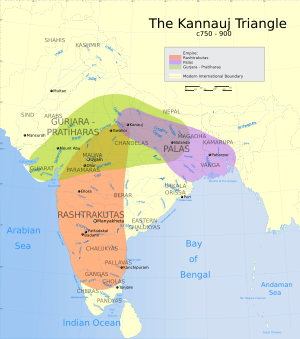Devapala (Pala dynasty) facts for kids
Quick facts for kids Devapala |
|
|---|---|

Pala empire with neighbours
|
|
| Pala Emperor | |
| Tenure | 9th century |
| Predecessor | Dharamapala |
| Successor | Mahendrapala |
| Spouse | Mahata Devi |
| Issue | Mahendrapala Shurapala I |
| Dynasty | Pala |
| Father | Dharamapala |
| Mother | Rannadevi |
| Religion | Buddhism |
Devapala was a very powerful ruler of the Pala Empire in the 9th century. This empire was located in the Bengal region of the Indian Subcontinent. He was the third king of the Pala dynasty. Devapala took over after his father, Dharmapala. He made the empire much bigger by taking over areas that are now Assam and Odisha. Ancient writings about him also say he won many other battles.
Devapala's Rule
Devapala became king after his father, Dharmapala. His mother was Rannadevi, who was a princess from the Rashtrakuta kingdom. Devapala ruled for about 40 years.
Historians have studied old records to figure out when Devapala ruled. Most agree his reign was in the 9th century. He was a strong leader who helped the Pala Empire grow.
Expanding the Pala Empire
Devapala sent his cousin and general, Jayapala, on military trips. Jayapala was the son of Dharmapala's younger brother. These trips led to the invasion of Pragjyotisha (which is now Assam). The king there gave up without a fight. They also invaded Utkala (which is now Odisha). The king of Utkala ran away from his capital city.
An old stone writing, called the Badal Pillar inscription, says Devapala's empire reached far and wide. It claims his empire stretched from the Vindhya mountains to the Himalayas. It also said it reached two oceans, probably the Arabian Sea and the Bay of Bengal. The inscription also claims he defeated the people of Utkala and Pragjyotisha. It says he humbled the Hunas, Gurjaras, and Dravidas.
While these claims might be a bit exaggerated, they show Devapala was very successful. The neighboring kingdoms, like the Rashtrakutas and Gurjara-Pratiharas, were not very strong at that time. This made it easier for Devapala to expand his empire. The "Gurjaras" likely refers to the Gurjara-Pratiharas. The "Hunas" were probably a group in North-West India. "Dravida" might refer to the Rashtrakutas.
Devapala's empire was mainly in the northern parts of India. There is no clear proof that his army went all the way to the far south.
Supporting Buddhism
Devapala was a strong supporter of Buddhism. He is said to have ordered the building of many temples and monasteries in Magadha. He also helped maintain the famous Buddhist monastery at Uddandapura (Odantapuri).
A king from Java, named Balaputradeva, sent a messenger to Devapala. He asked Devapala for land to build a monastery at Nalanda. Devapala agreed to this request. He also supported the famous Vikramashila University and the Nalanda University.
A Buddhist poet named Vajradatta was part of Devapala's royal court. Vajradatta wrote a famous poem called Lokesvarashataka.
Who Ruled Next?
Devapala ruled for about 40 years. For a long time, historians thought his successors were Shurapala I or Vigrahapala I.
However, in the 2000s, a new copper plate was found at Jagjivanpur. This plate showed that a king named Mahendrapala had made a grant in 854 CE. Mahendrapala was Devapala's son. He was also the brother of Shurapala I. Both Mahendrapala and Shurapala I were sons of Queen Mahata. So, Mahendrapala was Devapala's direct successor.
| Preceded by Dharmapala |
Pala Emperor 9th century |
Succeeded by Mahendrapala |

